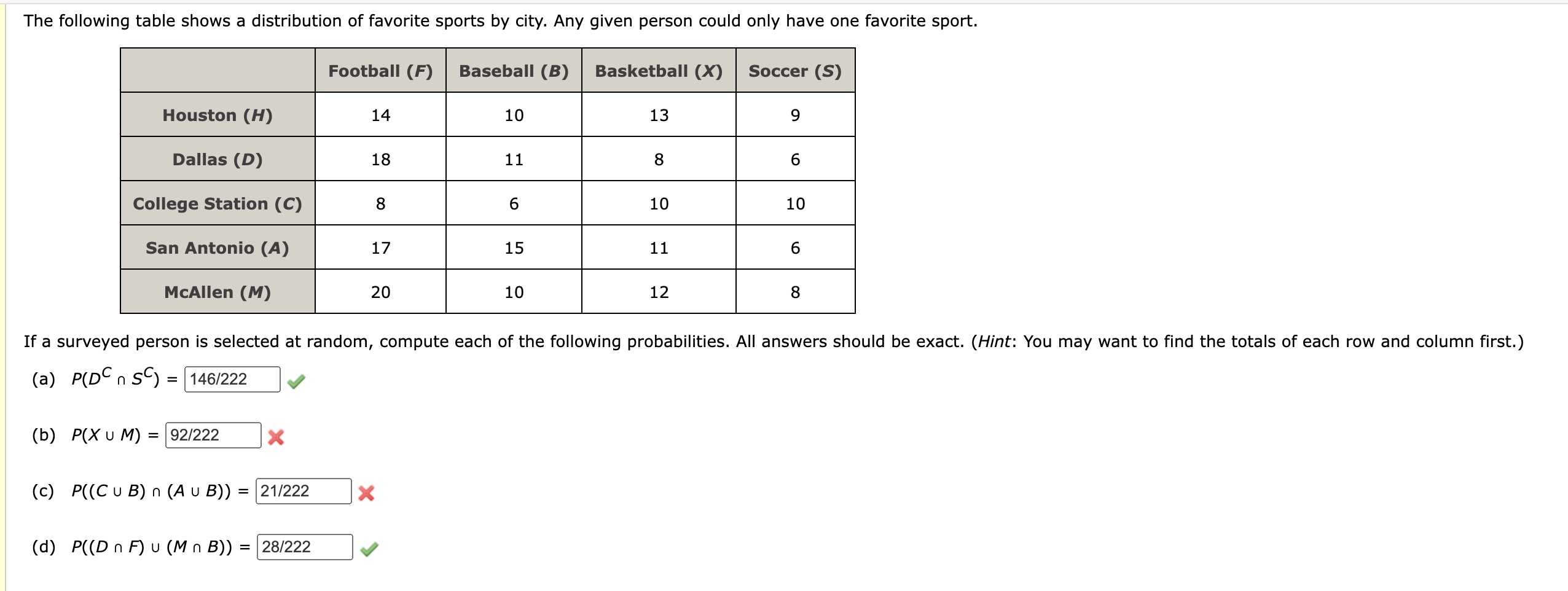Given the data table of favorite sports by city, calculate the following probabilities: (a) P(D^C ∩ S^C) (b) P(X ∪ M) (c) P((C ∪ B) ∩ (A ∪ B)) (d) P((D ∩ F) ∪ (M ∩ B)) Given the data table of favorite sports by city, calculate the following probabilities: (a) P(D^C ∩ S^C) (b) P(X ∪ M) (c) P((C ∪ B) ∩ (A ∪ B)) (d) P((D ∩ F) ∪ (M ∩ B))

Understand the Problem
The question provides a table of data showing favorite sports by city and asks to calculate various probabilities based on the events described. This involves understanding set theory notation (union, intersection, complement) and applying it to the dataset to find the desired probabilities.
Answer
(a) $P(D^C \cap S^C) = \frac{146}{222}$ (b) $P(X \cup M) = \frac{92}{222}$ (c) $P((C \cup B) \cap (A \cup B)) = \frac{52}{222}$ (d) $P((D \cap F) \cup (M \cap B)) = \frac{28}{222}$
Answer for screen readers
(a) $P(D^C \cap S^C) = \frac{146}{222} = \frac{73}{111}$ (b) $P(X \cup M) = \frac{92}{222} = \frac{46}{111}$ (c) $P((C \cup B) \cap (A \cup B)) = \frac{52}{222} = \frac{26}{111}$ (d) $P((D \cap F) \cup (M \cap B)) = \frac{28}{222} = \frac{14}{111}$
Steps to Solve
- Calculate row and column totals
First, we need to calculate the total number of people surveyed in each city and the total number of people who favor each sport. The grand total of all surveyed people is also required.
City Totals: Houston (H): $14 + 10 + 13 + 9 = 46$ Dallas (D): $18 + 11 + 8 + 6 = 43$ College Station (C): $8 + 6 + 10 + 10 = 34$ San Antonio (A): $17 + 15 + 11 + 6 = 49$ McAllen (M): $20 + 10 + 12 + 8 = 50$
Sport Totals: Football (F): $14 + 18 + 8 + 17 + 20 = 77$ Baseball (B): $10 + 11 + 6 + 15 + 10 = 52$ Basketball (X): $13 + 8 + 10 + 11 + 12 = 54$ Soccer (S): $9 + 6 + 10 + 6 + 8 = 39$
Grand Total: $46 + 43 + 34 + 49 + 50 = 222$ (or $77+52+54+39=222$)
- Calculate P(X ∪ M)
$P(X \cup M) = P(X) + P(M) - P(X \cap M)$ $P(X) = \frac{54}{222}$ $P(M) = \frac{50}{222}$ $P(X \cap M) = \frac{12}{222}$ (Number of people in McAllen who like basketball)
$P(X \cup M) = \frac{54}{222} + \frac{50}{222} - \frac{12}{222} = \frac{54 + 50 - 12}{222} = \frac{92}{222} = \frac{46}{111}$
- Calculate P((C ∪ B) ∩ (A ∪ B))
$P((C \cup B) \cap (A \cup B)) = P((C \cap A) \cup B)$ $C \cap A = \emptyset $, therefore $P(C \cap A) = 0$ So, $P((C \cap A) \cup B) = P(B) = \frac{52}{222} = \frac{26}{111}$
Another way by Venn Diagrams: $(C \cup B) \cap (A \cup B) = (C \cap A) \cup B = \emptyset \cup B = B$ $P(B) = \frac{52}{222} = \frac{26}{111}$
- Calculate P((D ∩ F) ∪ (M ∩ B)) $P((D \cap F) \cup (M \cap B)) = P(D \cap F) + P(M \cap B) - P((D \cap F) \cap (M \cap B))$ $P(D \cap F) = \frac{18}{222}$ $P(M \cap B) = \frac{10}{222}$ Since $(D \cap F)$ and $(M \cap B)$ are mutually exclusive, then $P((D \cap F) \cap (M \cap B)) = 0$
$P((D \cap F) \cup (M \cap B)) = \frac{18}{222} + \frac{10}{222} - 0 = \frac{28}{222} = \frac{14}{111}$
(a) $P(D^C \cap S^C) = \frac{146}{222} = \frac{73}{111}$ (b) $P(X \cup M) = \frac{92}{222} = \frac{46}{111}$ (c) $P((C \cup B) \cap (A \cup B)) = \frac{52}{222} = \frac{26}{111}$ (d) $P((D \cap F) \cup (M \cap B)) = \frac{28}{222} = \frac{14}{111}$
More Information
The probability of an event is a number between 0 and 1, inclusive, that represents the likelihood of the event occurring. It is calculated by dividing the number of favorable outcomes by the total number of possible outcomes.
Tips
A common mistake is misinterpreting the set operations (union, intersection, complement) and applying them incorrectly to the data. For example, the student may incorrectly calculate the intersection or union of events, leading to an incorrect count of favorable outcomes.
Another common mistake is not simplifying the probabilities to their simplest form.
AI-generated content may contain errors. Please verify critical information